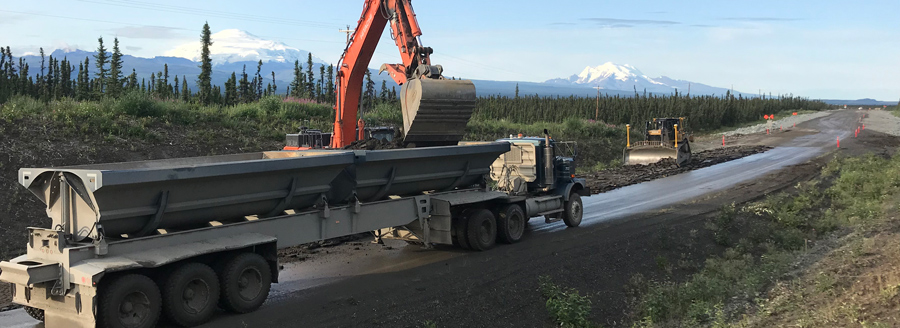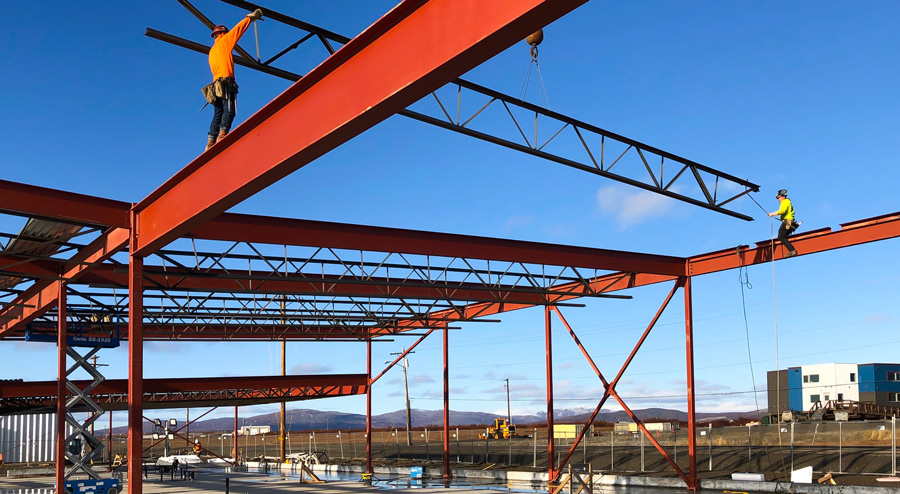Photo courtesy of Stephen Nowers, Cruz Construction

Photo courtesy of Stephen Nowers, Cruz Construction
Alaska-related funding and opportunities in the Infrastructure Investment and Jobs Act
*Note: unless otherwise noted, numbers are nationwide program funding over five years.
Roads/Bridges:
- Authorizes $273 billion in federal-aid highway formula funding that will provide roughly $3.5 billion in highway funding for Alaska over five years to construct, rebuild, and maintain roads and highways.
- Provides $40 billion in funding for bridge construction, maintenance, and repair. Of that, $27.5 billion will be apportioned by formula. Alaska should receive $225 million to address more than 140 bridges considered to be “structurally deficient.”
- This includes $1 billion for the replacement of culverts.
- There is an additional $11 billion for highway and pedestrian safety programs, including significant investment in the Safe Streets Program, which aims to prevent death and serious injury to cyclists on roads and streets.
- Of almost $65 billion in total funding for Federal Transit Administration, Alaska is expected to receive $362 million over five years for a mix of transit formula grants.
Airports:
- $15 billion in formula funding for the FAA Airport Improvement Program that supports projects such as planning, installing, and expanding runways, gates, and taxiways and improving runway lighting and navigation.
- $5 billion for FAA’s Facilities and Equipment Program, which includes funding for FAA-owned Air Traffic Control facilities and contract towers.
- $5 billion in grants for a new Airport Terminal Improvement Program, which includes set-asides for small hub airports, non-hub, and non-primary airports, ensuring airports in communities of all sizes benefit.
Buses/Ferries:
- $1 billion for a new program that establishes an essential ferry service to support rural communities. This program, which was proposed by Senator Lisa Murkowski, will provide funding to the Alaska Marine Highway System.
- $250 million for an electric or low-emitting ferry pilot program, with at least one pilot to be conducted in Alaska.
- $342 million for the Construction of Ferry Boats and Ferry Terminal Facilities Program, of which Alaska should receive $73 million. Provides an authorization for recipients of funding under the program to spend on ferry operating costs.
- $5.25 billion for the Low or No Emission Vehicle Program that supports the purchase of zero-emission and low-emission transit buses and construction of supporting facilities.
Railroads:
- $5 billion for the Consolidated Rail Infrastructure and Safety Improvement Program to assist the Alaska Railroad with critical capital projects and rail safety technologies.
Water:
- Provides more than $180 million over five years for water and wastewater projects in Alaska through the Clean Water State Revolving Fund and Drinking Water State Revolving Fund programs.
- $3.5 billion for Indian Health Services sanitation facilities. This unprecedented investment in sanitation infrastructure will clear all known project needs.
- $10 billion for states to address Per- and Polyfluoroalkyl Substances, or PFAS, contamination through clean water and drinking water programs, with a focus on small and disadvantaged communities.
- Authorizes $230 million for the EPA Alaska Native villages grant program to support communities with new and improved wastewater and drinking water systems and to provide technical assistance for the operation and maintenance of these systems. Increases the federal cost share from 50 percent to 75 percent.
Denali Commission:
- Provides $75 million for the Denali Commission, which funds economic development and infrastructure in rural Alaska.
Permitting:
- Permanently authorizes the FAST-41 permitting dashboard, which has saved infrastructure projects more than a billion dollars through reduced permitting timelines.
Broadband:
- Provides $42 billion in grants to states for the deployment of broadband, with a minimum allocation of $100 million for each state.
- There is a dedicated carve out for high-cost areas for broadband deployment and $600 million for states to issue private activity bonds for deployment in rural areas.
- Additional $2 billion for tribes through the Tribal Broadband Connectivity Grant Program and $1 billion for Middle Mile Broadband Infrastructure grants.
- Allows the Denali Commission to provide the required matching funds for grant recipients.

Photo courtesy of Swalling General Contractors
Ports:
- $2.25 billion for the Port Infrastructure Development Program, which provides critical support to ports throughout Alaska.
- Provides $250 million for remote and subsistence harbor construction. This will go toward building ports in rural areas.
Resilience:
- $216 million is included over five years for tribal climate resilience, adaptation, and community relocation planning, design, and implementation of projects which address the varying climate challenges facing tribal communities across the country.
Energy and Natural Resources:
- $355 million for the Energy Storage Demonstration Projects and Pilot Grants Program, which ensure more efficient energy storage infrastructure.
- $3.21 billion for Advanced Reactor Demonstration Project, which will allow more headroom for micro reactors.
- $146.4 million to carry out hydropower and marine energy research.
- $264 million in funding for geothermal, wind, and solar energy projects.
- Removes barriers to participation by Alaska Native and Indian Tribes in programs that are part of the bill’s Energy Infrastructure Act.
- Includes more than $4.7 billion for orphaned well cleanup, including Alaska’s legacy wells in the NPR-A.
Supply Chains for Clean Energy Technologies
- More than $825 million to strengthen mineral security.
- $23 million is provided for the National Geological and Geophysical Data Preservation Program, which sustains the Geologic Materials Center in Anchorage.
- $320 million for the Earth Mapping Resources Initiative that will help us better understand the quantity, type, and location of mineral resources in Alaska.
- More than $6 billion for battery processing and manufacturing, including grants for commercial-scale battery materials processing facilities.
Fuels and Technology Infrastructure Investments
- More than $34 billion for carbon capture and storage and related programs, hydropower funding, clean hydrogen, and civil nuclear credits.
- Secures $100 million for the Bureau of Reclamation to establish a program for small water storage projects, including in Alaska and Hawaii.
- Repeals a limitation on $18 billion in loan guarantees set aside for an Alaska gasline, ensuring the gasline can access the funds.
Grid Infrastructure and Resiliency
- Includes a set-aside for small utilities of 30 percent of program funds aimed at preventing outages and enhancing resilience of the electric grid.
- $1 billion specifically for rural or remote areas (populations not more than 10,000) to improve the resiliency, safety, reliability, and availability of energy.
Energy Efficiency and Building Infrastructure
- More than $6 billion included for energy efficiency measures across the whole bill, including $250 million for loan fund capitalization grants, $3.5 billion for the Weatherization Assistance Program, $550 million for energy efficiency and Conservation Block Grants, and $225 million for efficiency and resiliency code implementation.
Natural Resources-Related Infrastructure, Wildfire Management, and Ecosystem Restoration
- $250 million for decommissioning, road and trail repair, and maintenance and removal of fish passage barriers.
- More than $3.3 billion to conduct mechanical thinning, controlled burns, fuel breaks, and other activities to reduce wildfire risk on Department of the Interior and Forest Service lands, including in Alaska.
- Includes a specific carve out of $20 million for construction, reconstruction, operation and maintenance of recreation public use cabins.
- $100 million for workforce training for firefighting and vegetation management that specifically includes Native village fire crews.
- A three-year extension of the Secure Rural Schools Program to 2023.
Source: US Sen. Lisa Murkowski